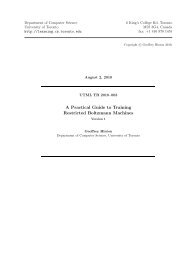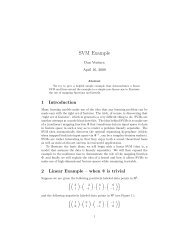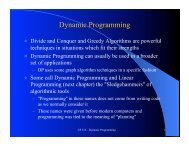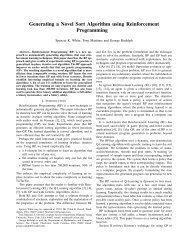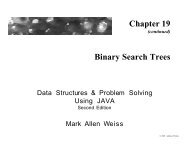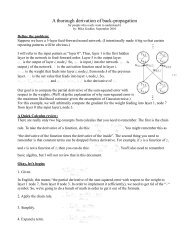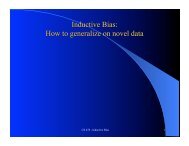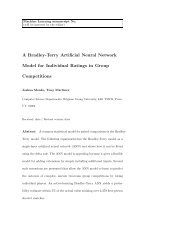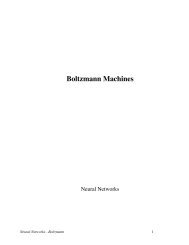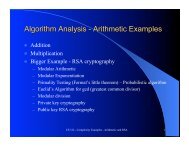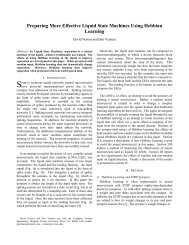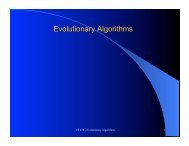A Collaboration with DARCI - Neural Network and Machine ...
A Collaboration with DARCI - Neural Network and Machine ...
A Collaboration with DARCI - Neural Network and Machine ...
You also want an ePaper? Increase the reach of your titles
YUMPU automatically turns print PDFs into web optimized ePapers that Google loves.
A <strong>Collaboration</strong> <strong>with</strong> <strong>DARCI</strong>David Norton, Derrall Heath, Dan VenturaBrigham Young UniversityComputer Science DepartmentProvo, UT 84602dnorton@byu.edu, dheath@byu.edu, ventura@cs.byu.eduAbstractWe briefly outline several different ways in which <strong>DARCI</strong>, abudding digital artist, can interact <strong>with</strong> people in an artisticsense. These include acting as the medium for sociologicalexperiments, acting as artistic juror, acting as artistic collaborator,<strong>and</strong> modifying environment to affect mood.Keywordscreative process, art, collaboration, evolutionary systemCopyright is held by the author/owner(s). Semi-AutomatedCreativity Workshop, Nov 3, 2011, Atlanta, GA, US.ACM Classification KeywordsI.2.m Artificial Intelligence: Miscellaneous
Introduction<strong>DARCI</strong> (Digitial ARtist Communicating Intention) is a computersystem designed to eventually produce original <strong>and</strong>meaningful images [4, 5]. Inspired by Csíkszentmihályi’s systemsmodel of creativity [1], <strong>DARCI</strong> is designed to functionin a social environment. She begins by learning how to associatelanguage <strong>with</strong> images through online training by humanteachers. Currently, <strong>DARCI</strong> can only associate adjectives <strong>with</strong>low-level features extracted from image, but in the future,she may be able to associate much more. This underst<strong>and</strong>ingof language provides the basis for <strong>DARCI</strong> to produce originalimages herself. Currently, when provided <strong>with</strong> a source image<strong>and</strong> list of adjectives, <strong>DARCI</strong> can render the source tomatch the adjectives in an original way. Eventually, she willbe able to produce entirely original images <strong>and</strong> communicatethe intention of her artifacts through the language she is developing.She will use the social <strong>and</strong> environmental contextof each moment, as informed by data obtained from the internet,as well as her training to make decisions regardingthe creation of her artifacts.<strong>DARCI</strong> is partially dependent upon her interaction <strong>with</strong> humanteachers in order to learn meaning. At <strong>DARCI</strong>’s website(http://darci.cs.byu.edu) volunteers can view r<strong>and</strong>omimages <strong>and</strong> describe them for <strong>DARCI</strong>. Additionally, <strong>DARCI</strong>will describe images herself <strong>and</strong> volunteers can correct anymistakes they feel she has made. This is very similar to astudent-teacher interaction among humans. With a series ofneural networks trained <strong>with</strong> this human labeled data, <strong>DARCI</strong>learns to associate descriptions <strong>with</strong> combinations of imagefeatures present in the images. She is then able to generalizethis knowledge to images that she has never seenbefore. Currently, <strong>DARCI</strong>’s descriptions include only lists ofadjectives; but in the future, these descriptions could be exp<strong>and</strong>edto natural speech. <strong>DARCI</strong> can also assign quantitativevalues to the image-adjective associations. For example, shecan indicate how “abstract” an image is. In this way, <strong>DARCI</strong>can analyze <strong>and</strong> evaluate any images she is presented <strong>with</strong>,including her own attempts at art. Figure 1 shows a briefoutline of the system.Figure 1: Overview of <strong>DARCI</strong>’s artifact creation process.Sociological ExperimentsSince <strong>DARCI</strong>’s concept of meaning is shaped by those whotrain her, what she produces <strong>and</strong> how she judges art is directlyimpacted by her environment. This yields the possibilityfor an interesting study analyzing different social groups.One group of individuals may perceive a particular imagefeature in a different light than another group. For example,what may be funny to one group is sacred to another.If different versions of <strong>DARCI</strong> were trained by distinct socialgroups, what would be the differences in her judgment <strong>and</strong>the artifacts she produces? In a sense, <strong>DARCI</strong> would act as afilter for the different social groups, providing a new lens toqualify social variances.
Figure 2: Photograph from the Fitness Function closing social,a gallery where <strong>DARCI</strong> acts as the sole juror.Figure 3: An image, created <strong>with</strong> picbreeder, used by <strong>DARCI</strong>as the source for Figures 4-6.Judge <strong>and</strong> Juror<strong>DARCI</strong>’s ability to learn artistic associations between language<strong>and</strong> art enables her to evaluate <strong>and</strong> make certain judgmentsof art. <strong>DARCI</strong> could act as an art critic or juror. Museumcurators could enlist <strong>DARCI</strong>’s help to evaluate incomingartifacts <strong>and</strong> provide interesting insights that could help curatorsdecide whether or not an artifact makes it on display. Tosome extent this has been done already <strong>with</strong> <strong>DARCI</strong> actingas the sole curator for the show Fitness Function (see Figure2) which took place at Brigham Young University in 2010.An updated version of Fitness Function will also take place atACM Creativity <strong>and</strong> Cognition this year. A more collaborativeeffort between <strong>DARCI</strong> <strong>and</strong> museum curators would be veryinteresting. Curators could teach <strong>DARCI</strong> to look for certaincharacteristics which could help automate the selection process.<strong>DARCI</strong> could also be used as an “unbiased” judge toact as a counterbalance to the human curators. In any case,<strong>DARCI</strong> has the potential to be a helpful tool for art critics.Figure 4:A peaceful rendering created by <strong>DARCI</strong> of thesource image in Figure 3.
Figure 5: A happy rendering created by <strong>DARCI</strong> of the sourceimage in Figure 3.offering suggestions to the artist. For example, suppose theartist wanted to create something that communicates peace<strong>and</strong> a sense of calmness. <strong>DARCI</strong> could evaluate the artist’sinitial attempts <strong>and</strong> inform the artist of how peaceful <strong>and</strong> calmthe image is. <strong>DARCI</strong> could then offer suggestions on simpleways to make the artifact more peaceful <strong>and</strong> calm by providingseveral new renderings of the initial artifact. The suggestions<strong>and</strong> changes that <strong>DARCI</strong> proposes could give the artistnew ideas <strong>and</strong> may even cause the artist to take the imagein a completely different direction than originally envisioned.Thus the artist’s ability to create an artifact that communicatesthe message or feeling they intend is enhanced.Consider the following example of how this collaborationcould take place. Figure 3 is an image created <strong>with</strong> picbreeder(http://picbreeder.org/), an art application designed to createoriginal art through a human-in-the-loop evolutionary algorithm.Figures 4-6 show three renderings of Figure 3 createdby <strong>DARCI</strong> to reflect the adjectives peaceful, happy, <strong>and</strong> scaryrespectively. These renderings represent possible suggestions<strong>DARCI</strong> could give to an artist trying to decide where togo from the source in Figure 3. Using the picbreeder imageas a source also gives some indication for what <strong>DARCI</strong> maybe able to do automatically once she generates the sourceimage herself in addition to the rendering rules.Figure 6: A scary rendering created by <strong>DARCI</strong> of the sourceimage in Figure 3.Artistic <strong>Collaboration</strong><strong>DARCI</strong>’s ability to evaluate art could also be useful in a collaborativeeffort <strong>with</strong> the artists themselves. The artist couldcome up <strong>with</strong> an artifact <strong>and</strong> <strong>DARCI</strong> could provide feedbackAdaptable Art<strong>DARCI</strong> is intended to be an artificial artist that has the abilityto communicate meaning through its artifacts. The advantageof a digital artist would be its ability to automatethe rendering of artifacts. <strong>DARCI</strong> currently has the ability tomodify images to reflect the meaning of certain adjectives.This would be useful in a public setting such as an airport,hotel, classroom, doctor’s office, or even popular websites.The art on the walls could adapt <strong>and</strong> change automatically tocommunicate a certain mood or theme to those in the room.
For example, the art in a hotel could be something bright <strong>and</strong>energetic in the mornings, while at night the art could exudea more relaxed <strong>and</strong> peaceful tone. The art could also adaptto the weather to promote a feeling of warmth when it is coldoutside or calm <strong>and</strong> happy if it is stormy. The art on displaycould adapt to seasons <strong>and</strong> holidays like becoming dark <strong>and</strong>scary during the Halloween season.Development <strong>and</strong> Future WorkAs previously mentioned <strong>DARCI</strong> is currently limited to adjectives,<strong>and</strong> can only associate these adjectives <strong>with</strong> low-levelimage features (such as color <strong>and</strong> texture). Furthermore,<strong>DARCI</strong> can only produce original renderings of existing works.Our next step in <strong>DARCI</strong>’s development will include the generationof original images through a combination of algorithmicart <strong>and</strong> image collaging algorithms [2, 3]. <strong>DARCI</strong>’s evaluationmethods will continue to guide the direction of these processes.We will endow <strong>DARCI</strong> <strong>with</strong> the ability to identify <strong>and</strong>build a cognitive model of individual teachers, enabling herto have an “opinion” of those who provide her training data.We will also add web-crawling to <strong>DARCI</strong>’s learning opportunities.Common natural language algorithms will be used toautomatically label the myriad images available online for additionaltraining data. We will continue to refine <strong>and</strong> add tothe image features that <strong>DARCI</strong> can recognize, possibly combiningthat image data <strong>with</strong> the textual context of images(this will always be secondary to actual visual data).Eventually we will add noun <strong>and</strong> verb parts of speech to<strong>DARCI</strong>’s repertoire. In conjunction <strong>with</strong> this, we plan to usecomputer vision techniques to allow <strong>DARCI</strong> to build abstractmodels of objects contained <strong>with</strong>in images. We will then addmetaphor synthesis to <strong>DARCI</strong>’s skill set <strong>and</strong> use this to helpdirect her image creation. Around this time <strong>DARCI</strong> will be ableto extract useful information from web text <strong>and</strong> use commonnews sites to fuel her “mood”. This combined <strong>with</strong> metaphorgeneration will drive <strong>DARCI</strong>’s artistic intention allowing herto, on occasion, produce original images <strong>with</strong>out any directinput from users. Of course, user input <strong>and</strong> feedback willbe a continuous part of her development. <strong>DARCI</strong> will acceptcommissions from users <strong>and</strong> respond to their criticism.Conclusions<strong>DARCI</strong> is a system designed to eventually be creative <strong>with</strong>in asocial context. In its early stages, <strong>DARCI</strong> has already inspiredstrong human-machine interaction. In fact, at this year’s ACMCreativity <strong>and</strong> Cognition conference we will present a paperdescribing a study that involves art students’ interactions <strong>with</strong><strong>DARCI</strong>. Specifically, we will detail activities that the studentsdesigned to interpret <strong>DARCI</strong>’s perspective <strong>and</strong> thus better underst<strong>and</strong>their own creative processes. As our work on <strong>DARCI</strong>proceeds, the ensuing dialogue between artist <strong>and</strong> machinewill continue to develop.AcknowledgmentsThis material is based upon work supported by the NationalScience Foundation under Grant No. IIS-0856089.References[1] M. Csikzentmihalyi. Creativity. HarperCollins Publishers,1996.[2] T. de Smedt, F. D. Bleser, <strong>and</strong> L. Nijs. Nodebox 2. Proceedingsof the International Symposium on ElectronicArt, pages 350–352, 2010.[3] A. Krzeczkowska, J. El-Hage, S. Colton, <strong>and</strong> S. Clark. Automatedcollage generation—<strong>with</strong> intent. Proceedings ofthe International Conference on Computational Creativity,pages 36–40, 2010.
[4] D. Norton, D. Heath, <strong>and</strong> D. Ventura. Establishing appreciationin a creative system. Proceedings of the InternationalConference on Computational Creativity, pages26–35, 2010.[5] D. Norton, D. Heath, <strong>and</strong> D. Ventura. Autonomously creatingquality images. Proceedings of the InternationalConference on Computational Creativity, pages 10–15,2011.




